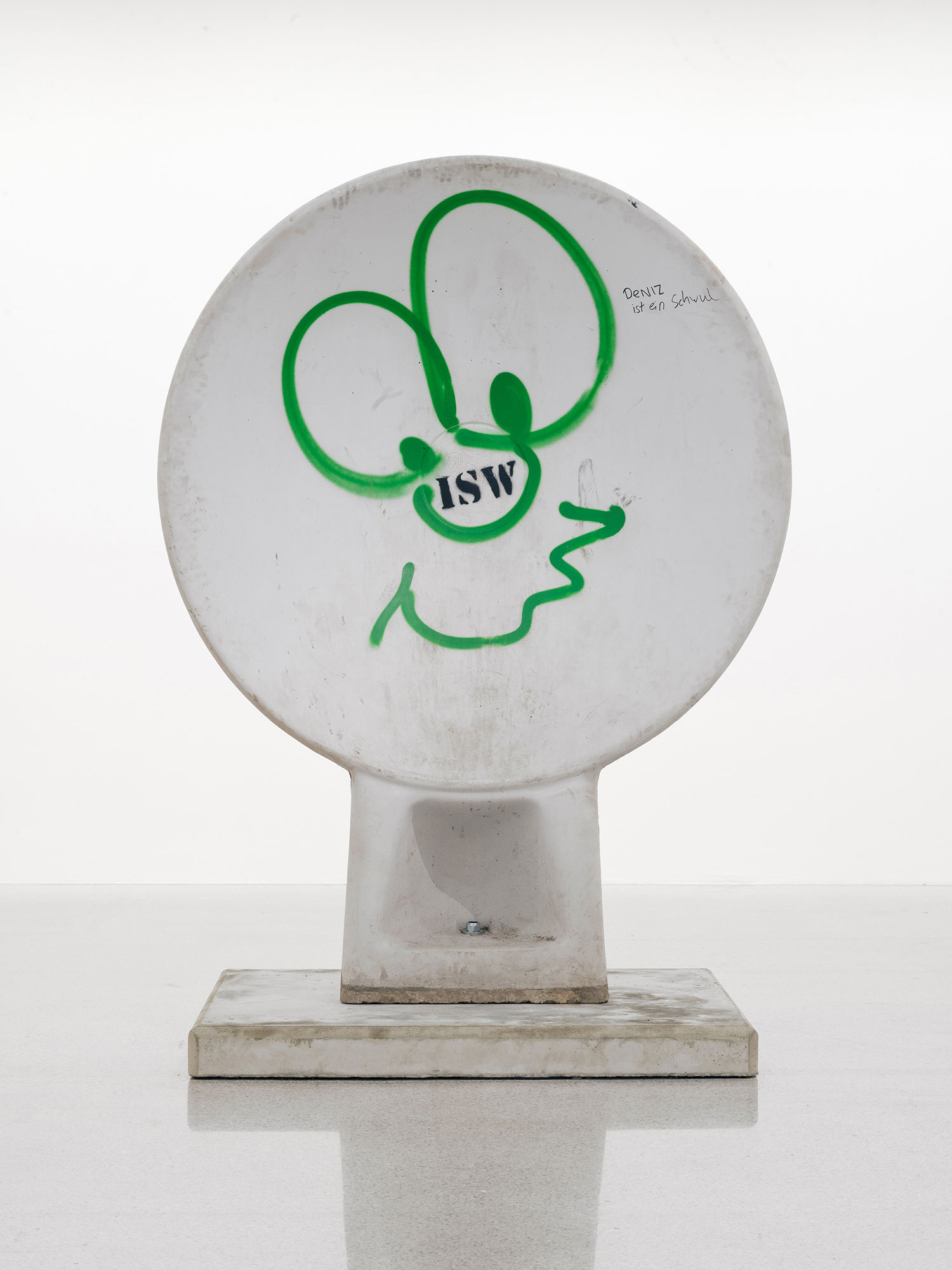
If you are wondering whether there is anything progressive about the politics of the art world or if the politics of identity can in any way mark a path forward for the left, you can get both your answers from the Kelley Walker show at the Contemporary Art Museum St. Louis: No.
Start with identity. By now everyone who cares knows the basics. Among the works that Walker showed in St. Louis were several that had photographic images of black people — some, as the catalogue discreetly says, “in parallel” to Andy Warhol’s 1964 Race Riot, some appropriated from the cover of King magazine — layered over with scans of smeared chocolate (Lindt) and/or toothpaste (both Aquafresh and Crest). These works (or versions of them) are well known and have been frequently written about. Sometimes reservations have been expressed about Walker’s use of “racially charged” materials, but mainly that’s been either ignored or defended, including by black (the descriptor matters here) writers. In 2010, for example, Glenn Ligon characterized Walker as having, “like many other white Americans,” a “healthy, wholesome, complicated, troubling, and troubled obsession with black people,” and described that obsession as giving “enormous vitality to his work” [“Kelley Walker’s Negro Problem,” Parkett vol. 87, 2010, p. 81]. In the publication that accompanied the exhibition, Hilton Als praises Walker’s “authenticity,” saying the work says more to him “about America and its obsession with race… than work by many artists of color” [Hilton Als, “Yvonne” in Kelley Walker: Black Star Press, CAM St. Louis, 2016, p. 35]. So for at least ten years, the worries about “a white person… making an artwork by pouring real chocolate over an image of racial tragedy,” as expressed by Ken Johnson back in 2006, did not prove to be a deal breaker [nytimes.com/2006/03/17/arts/art-in-review-kelley-walker.html].
When the show went up in St. Louis, however, and especially after Walker met with people in what appears to have been a catastrophic question-and-answer period, all that changed. The most outspoken critic, “local artist and activist” Damon Davis (“best known,” according to the St. Louis American, “for his positive creative responses to the Ferguson uprising”), called for a boycott and wrote an essay titled “In the Face of White Male Privilege Run Amok, a Plea for Artistic Responsibility” [hyperallergic.com/325780/in-the-face-of-white-male-privilege-run-amok-a-plea-for-artistic-responsibility]. And many, many others joined in. By the time I saw the show, two months later, the whole lobby of the museum had been turned into a kind of trigger warning: the offending pieces were walled off so you couldn’t see them unless you chose to; signs cautioned, “This gallery contains content that some viewers have found to be offensive”; another wall was made available for visitors to express their outrage in notes (e.g. “Our pain is not art”); and printouts from various media sources, complaining about the “offensive” and “traumatizing” effect of the art, were distributed throughout.
It’s not hard to see what made the difference between Glenn Ligon celebrating Walker’s “chocolaty transgressions” [“Kelley Walker’s Negro Problem,” p. 80] and Damon Davis excoriating him for them — Ferguson, Baltimore, Black Lives Matter. But it’s more relevant to note that even though we’ve moved from approval to disapproval, Davis’s complaint that “There is no deeper meaning behind the work other than Walker’s obsession with Black people and culture” [Ibid.] more or less echoes Ligon’s and Als’s compliments: it’s Walker’s “obsession with black people” that gives his work its vitality, it’s his “obsession with race” that makes him authentically American.

From this standpoint, it will turn out not to matter very much whether we think (with his critics) that this obsession is a form of racism or (with his defenders) that it resists racism. What matters is that we identify it with what Als correctly calls not just Walker’s but America’s obsession with race, and that we begin to recognize the way in which that obsession in itself serves a political function, one best understood by juxtaposing it with slogans like “fight capitalism” and “resist capitalism” that appear on two pieces from Walker’s “Disasters” series. As it happens, there’s also been a bit of a debate about how serious Walker is about this aspect of his politics, but no one’s ever called for one of his shows to be boycotted because it was insufficiently anticapitalist or because, say, it disrespected the working class. In fact, no one’s been calling for anybody’s shows to be boycotted because they’re insufficiently anticapitalist, and it’s not because the art world’s commitment to fighting capitalism is so thoroughgoing that every show successfully passes some socialist ideological purity test. It’s because both art-world institutions like CAM St. Louis and the segment of the community it outraged aren’t the slightest bit anticapitalist, and because antiracism and the obsession with race function not as a critique of capitalism but as some of the first lines of its defense.
Kelley Walker was born in 1969. The year before, 1968, was the year in which American incomes were the most equal they’ve been in a century. By the time he was ten, the spectacular rise in inequality that has marked the neoliberal period was well underway. The top one percent of families in the US were making ten percent of the country’s total income; today, it’s more than twenty percent [blogs.lse.ac.uk/usappblog/2014/10/29/the-explosion-in-u-s-wealth-inequality-has-been-fuelled-by-stagnant-wages-increasing-debt-and-a-collapse-in-asset-values-for-the-middle-classes/]. And distribution of wealth is even worse; the top ten percent of the population has seventy-six percent of the country’s total wealth; the entire bottom half has just one percent.
Most of that bottom half, as the recent election has reminded us, is white, but a disproportionately high number is black. Hence there are large gaps between white and black wealth, and the point of antiracism is to eliminate those gaps. It’s this fact and this goal that raise what Ligon calls the “very difficult” question of “the politics of representation” [“Kelley Walker’s Negro Problem,” p. 79] in both its senses. The first sense is straightforwardly numerical: how do we create a society in which black and white people are proportionately represented at every economic level? In which, for example, black and white (and male and female) artists are proportionately represented in major museums and major galleries. The second sense — the one raised more directly by Walker’s whiteness — is about whether his mode of representing black people is an expression of the racism that creates the economic problems of representation in the first place, a question, in effect, about the ways in which racist representations contribute to racist underrepresentation.
But while the problem of inequality between races and sexes does indeed have a lot to do with determining who gets represented in the different classes of American society, it has nothing to do with either the creation of, or the solution to, the problem of economic inequality as such. Eliminating the gaps between white and black would not eliminate the gaps between rich and poor, and it would have no effect on the mechanisms — busting unions, outsourcing production, uberizing the labor force — that produce those gaps. Indeed, with respect to fighting capitalism, there is no such thing as the politics of representation — no need to worry about whether rich people have the right to paint poor people, no need to worry about whether the artist is showing proper respect for his or her subjects. Protesting the Walker show, Damon Davis complains about the “classist” art world. But the inequalities of capitalism are not created by the upper class’s prejudice against the working class. In fact, the problem of the relation between capital and labor has nothing to do with capital’s attitude toward labor — it’s structural, not affective. And the question of how many poor people get to show their art in museums is a nonstarter; the point of the critique of capitalism is to get rid of poor people, not to make sure that they’re properly represented among the elite.
With respect to economic inequality, then, the moral outrage over Walker’s supposed racism is basically a smokescreen. Antiracism today is a way of defending class difference, since its whole point is not to eliminate the gap between the rich and the poor but to make it fairer, not to create a world where no one is poor but to create a world where no one’s poverty is an effect of discrimination. Furthermore, conservative economists think of antiracism, and antidiscrimination more generally, not only as a way of making capitalism fairer but also a way of making it work better, of making sure you get the best people for the job. If you’re making a commodity, it doesn’t matter if you’re black or white, man or woman, gay or straight; what matters is that people want to buy what you’ve made.

And here, of course, Walker has excelled. By this I don’t mean just that he has been successful and that his work sells. I mean that it’s made to sell. The Black Star Press works at the center of the St. Louis controversy have been produced in a series of changing formats, and Scott Rothkopf has noted that when the Coca-Cola Red ones (on display at CAM) were being made, Walker “not so secretly confided in” him that “with each iteration” in the series, he “had hoped to amp up the work’s desirability” [Kelley Walker, Zürich: JRP|Ringier, 2008, p. 119]. The goal, according to Rothkopf, was that “the collectors” of any individual work “might end up regretting that they hadn’t landed the one that came next.” Rothkopf says that this procedure “invokes… marketing tactics” like those of the Apple computers Walker works with. But “invokes” is almost exactly the wrong word here: he’s not invoking the tactics, he’s using them. He’s making work that he himself understands as designed above all to appeal to the beholder, and especially to the beholder as collector. That’s what I mean by saying that it’s made to sell. Rothkopf discreetly describes Walker as making work that will not appear “reproving, fawning, hypocritical, or tortured” about its place on the collector’s wall; a less discreet way to put it is that he makes work that appears positively gleeful about its place on the collector’s wall.
Indeed — and this is part of its particular interest — Walker’s work is characteristically designed with the buyer in view. Thus, in a gesture that is sometimes seen as subverting the market but in fact captures its essence, the CDs he sells, containing digital files of his works, accompanied by the instruction that the images can be reproduced, altered and disseminated as much as and as often “as desired,” explicitly thematize the logic of the customer is always right. If you want to print it and hang it on your wall, of course, that’s great. But you can alter the work or give away a few copies to your friends or, for that matter, break it into a dozen little pieces and spread them around in the garden, and it’s still great. You paid for it. As Nick Brown has insisted, from the standpoint of its producer, the commodity’s job is just to get you to buy it, and once you have, its work is done.
So it’s not just that Walker’s work isn’t very convincingly critical of capitalism. It’s that capitalism — the structure of the commodity — is built into his very idea of what a work of art is. Once you begin to understand yourself as making a commodity — designed above all to produce the beholder’s desire — it doesn’t really matter whether you write “resist capitalism” on it. The political meaning of the work is not in what it says but in what it is. When it says “resist capitalism,” what it means is “buy me.”
And, of course, this preoccupation with the beholder is by no means confined to Walker. CAM St. Louis defended its decision to keep the Walker show up by citing its commitment to presenting work that has “challenged common sensibilities,” a decision that Pamela Fraser criticized by pointing out that the museum didn’t seem to understand that “it is entirely different to offend members of a historically disenfranchised group than to challenge the status quo” [badatsports.com/2016/subversion-of-what-kelley-walkers-direct-drive-at-cam-st-louis]. But although it’s no doubt better to offend rich white people than poor black people (and would be better still to offend rich black people too), the desire to offend or to challenge is just the desire to attract, transposed into another key. Insofar as the art world is just the art market, in the hands of the right marketer they can both work pretty well. If, however, the goal is to make art where the political commitment isn’t indistinguishable from the sales plan, the first step is to stop caring so much about how the beholder feels. Of course, this isn’t easy, especially because, for the last half-century (ever since Michael Fried condemned it in “Art and Objecthood”), interest in the spectator has been booming. It’s no accident that the rise in neoliberal inequality has gone hand in hand with minimalist literalism, relational aesthetics and all the other ways we’ve invented to put the experience of the beholder at the center of aesthetic production. But sometimes the customer’s wrong.





